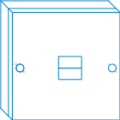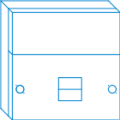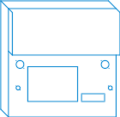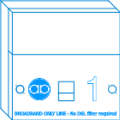Telephone Sockets: Difference between revisions
mNo edit summary |
mNo edit summary |
||
| Line 22: | Line 22: | ||
</gallery> |
</gallery> |
||
This is the 'standard' socket that Openreach will install, it has been the standard since the 1980's. The lower half is removable. Removing the lower half gives access to the 'Test Socket' as well as the connectors |
This is the 'standard' socket that Openreach will install, it has been the standard since the 1980's. The lower half is removable. Removing the lower half gives access to the 'Test Socket' as well as the connectors. |
||
=== NTE5 Open === |
|||
=== VDSL Faceplate === |
=== VDSL Faceplate === |
||
With an engineer installed FTTC (aka VDSL, BT Infinity) a VDSL faceplate is sometimes installed. The socket at the top is a RJ11 socket and should be connected to the FTTC modem or router. The Lower socket is a BT telephone socket for a phone to connect to. |
|||
=== Service Specific Faceplate === |
=== Service Specific Faceplate === |
||
=== Unfiltered Broadband Faceplate (Removed) === |
|||
=== Unfiltered Broadband Faceplate (AAISP Branded) === |
|||
=== Unfiltered Broadband Faceplate (Installed) === |
=== Unfiltered Broadband Faceplate (Installed) === |
||
Revision as of 14:31, 20 July 2015
Socket Overview
Non-NTE5
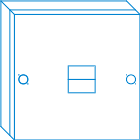 This socket could be an old style master socket, or it could be a secondary socket. Openreach should not be installing this style of socket as the master socket when installing a new phone line.
This socket could be an old style master socket, or it could be a secondary socket. Openreach should not be installing this style of socket as the master socket when installing a new phone line.
NTE5
This is the 'standard' socket that Openreach will install, it has been the standard since the 1980's. The lower half is removable. Removing the lower half gives access to the 'Test Socket' as well as the connectors.
VDSL Faceplate
With an engineer installed FTTC (aka VDSL, BT Infinity) a VDSL faceplate is sometimes installed. The socket at the top is a RJ11 socket and should be connected to the FTTC modem or router. The Lower socket is a BT telephone socket for a phone to connect to.
